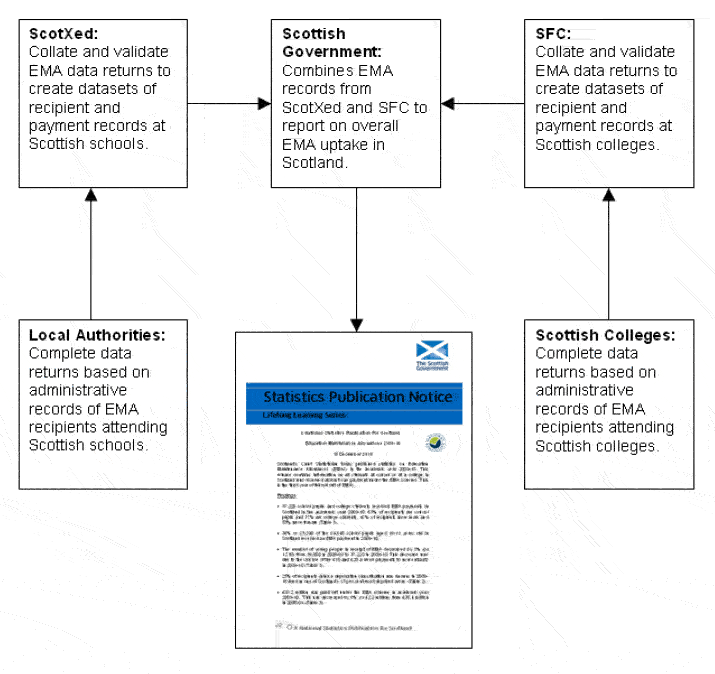Education Maintenance Allowances 2010-11
Statistics on Education Maintenance Allowances (EMAs) in the academic year 2010-11. This release contains information on all students at school or at a college in Scotland who received at least one payment under the EMA scheme. This is the fourth year of full roll out of EMAs.
Methodological Note
Data Sources
These statistics are collected by the Scottish Government from local authorities which administer Education Maintenance Allowance (EMA) payments to school pupils, and the Scottish Funding Council, which administers EMA payments to college students. Data returns from Local authorities are collated and validated by ScotXed, while those collected from colleges are collated and validated by the Scottish Funding Council (SFC) before being submitted to the Scottish Government.
Where analysis refers to institutions rather than schools or colleges, data from both Scottish schools and Scottish colleges has been combined to report on all Scottish institutions.

Coverage
EMAs are means tested payments to young people attending school or further education college on a full time basis. The data included in this publication covers all those participating in the EMA scheme, but not necessarily all those who are eligible to participate.
Although measures are taken within both the school and college data to minimise the chances or more than one record being created for the same student, an element of duplication is likely to still occur where a student moves from school into college in the same academic year. At the moment there is not a reliable way of identifying such cases. Efforts are being made to improve the collection of Scottish Candidate Numbers (SCNs) for EMA recipients in colleges. If this succeeds it may be possible to use SCNs, possibly in combination with other student characteristics, to identify those who move between school and college and therefore reduce any associated over-counting.
Age of Recipients
In this publication the age of recipients refers to their age on the 30th September 2010.
School Pupil Population
The proportion of all 16-19 year old school pupils that are in receipt of EMA is calculated in this publication using public and private school population data for Scotland. Following a consultation on the scope of Scottish Government School Statistics publications in September 2010, statistics have ceased to be collected and published on the Independent School Census. This year, the number of pupils aged 16-19 attending an Independent School in Scotland was estimated using proportions obtained from historic data. This estimation was then added to the 2010 Pupil Census figure of publicly funded secondary school pupils to achieve an estimate of the total 16 to 19 year old school population. This methodology will be reviewed in future years publications.
Recipients from Deprived Areas of Scotland
Analysis of entrants from deprived areas of Scotland is based on the Scottish Index of Multiple Deprivation (SIMD). The Scottish Index of Multiple Deprivation (2009) combines 38 indicators across 7 domains, namely: income, employment, health, education, skills and training, housing, geographic access and crime. The overall index is a weighted sum of the seven domain scores. The weighting for each domain is based on the relative importance of the domain in measuring multiple deprivation, the robustness of the data and the time lag between data collection and the production of the SIMD.
EMA recipients from deprived areas are those whose home address was within one of the 15 per cent lowest ranked areas in Scotland. The SIMD is split into 6,505 small areas called datazones, with the 15 per cent lowest ranked areas comprising of datazones 1 to 976. A process of postcode matching was undertaken to identify which datazones recipients belonged to prior to study. In 2010-11, 99.2% of recipients were successfully matched through this process. Those recipients whose postcodes belonged to one of the 15% lowest ranked datazones in the SIMD are classified as entrants from deprived areas.
More information on the Scottish Index of Multiple Deprivation can be found at the following web address: http://www.scotland.gov.uk/Topics/Statistics/SIMD.
Data Presentation
In all datasets figures on recipients have been rounded to the nearest 5 (0, 1 and 2 being rounded to 0). Figures on EMA spend have not been rounded. Unknown values are not displayed individually in tables but are included in totals. Figures may not sum to totals due to rounding and the inclusion of unknown values. Unless stated otherwise, percentages in tables are calculated from unrounded values. Percentages in the text of the publication are calculated from the figures displayed in the tables.
Contact
Email: Jeff Zinger
There is a problem
Thanks for your feedback